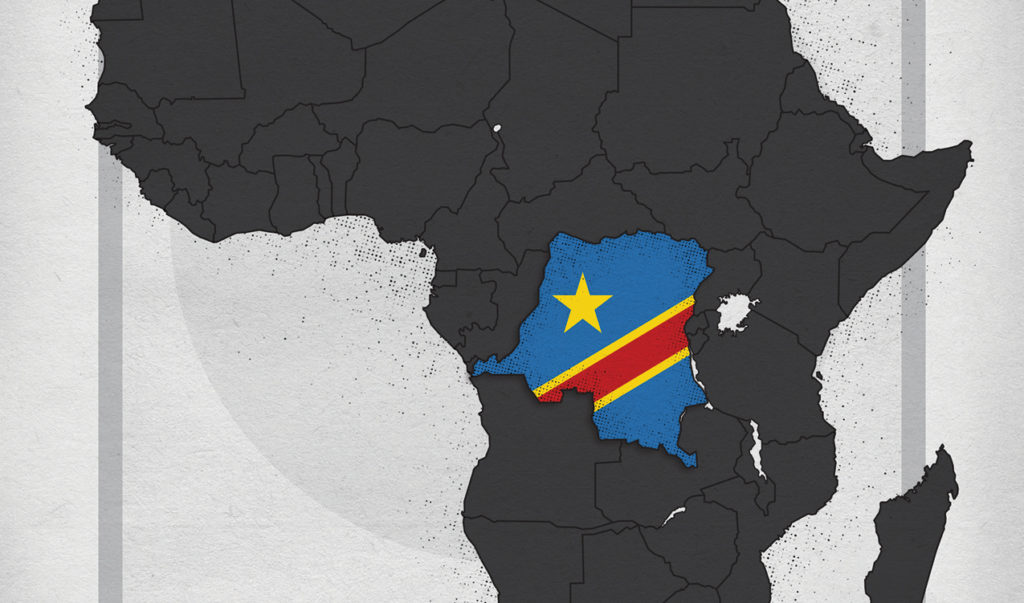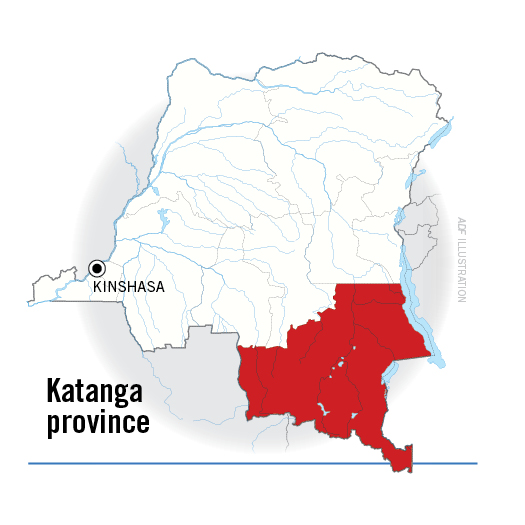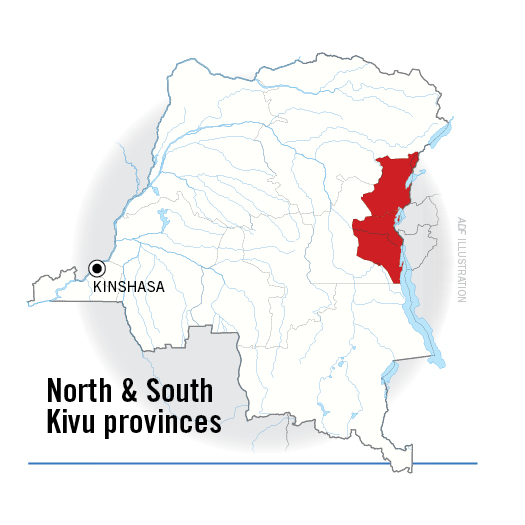Holdovers from History Hamper the Vast Nation’s Ability to Overcome Instability
ADF STAFF
The proliferation of armed groups in Africa’s second-largest country has destabilized the nation for decades, but an incident in December 2017 brought renewed attention to the dangers present in the Democratic Republic of the Congo (DRC).
The Allied Democratic Forces attacked United Nations personnel in the eastern DRC’s North Kivu province, killing 15 peacekeepers, at least five members of the DRC’s military, and wounding another 53 peacekeepers.
The three-hour firefight destroyed at least one armored personnel carrier, U.N. officials told The Washington Post. “This is the worst attack on U.N. peacekeepers in the organization’s recent history,” Secretary-General António Guterres said.
The Allied Democratic Forces, estimated to have 1,500 armed fighters, are responsible for other attacks on peacekeepers in the DRC: one in July 2013 and another in March 2014. The group is just one of about 70 armed militant and militia groups fomenting violence all across the DRC’s 2.3 million square miles.
The DRC should be among Africa’s most prosperous nations. Its diverse mineral reserves are almost without parallel. But the nation has suffered a complicated political history and has been at the center of two major continental wars. The scars still are visible today. A look at the nation’s history and some of its more troubled regions underscores the complexity of the security conditions within them.
THE BIRTH OF INSTABILITY
The DRC’s colonial roots date to 1880s Belgium. By 1908, Belgium, under King Leopold II, took official control of what was then called the Belgian Congo. Paul Nantulya, a research associate with the Africa Center for Strategic Studies, told ADF that the DRC’s complex problems cannot be understood outside its colonial history.
“Congo, or the territory that became Congo, was never governed as a country,” he said. “It was not meant to be a country. Congo was governed as a private estate of King Leopold.” Central to that “private estate” was the forced extraction of rubber, for which every able-bodied worker had a daily quota. Rubber extraction came at the expense of other long-standing economies, such as subsistence agriculture.
“You’re now producing for export, and you don’t own that production, so that introduces poverty, it introduces underdevelopment,” Nantulya said. “It basically makes underdevelopment systemic. And then it introduced violence, violence on a scale that had not been seen before.”
With resource exploitation came the architecture of governance custom-built for colonial authorities but ill-suited to effectively run a country as large as the DRC, with its many regions and social divisions. For example, the capital, Kinshasa, sits on the Congo River in the West, more than 1,500 kilometers by air from Goma, the capital of North Kivu province in the East, a current security hot spot.
THE CENTER DOESN’T HOLD
Colonial rule kept a powerful government center in what is now Kinshasa, far removed from 11 outlying regions, which were organized for forced labor. This “center-periphery dynamic,” as Nantulya calls it, kept provinces weak to avoid rebellions. After independence in 1960, that dynamic remained, and it was further exploited by Congolese leaders, such as President Mobutu Sese Seko.
In this system, hatred for the central government festered and often extended to local leaders, sparking secessionist sentiments. Those sentiments still exist today, and their complexity makes them difficult to overcome. Similar “center-periphery” problems also have arisen in Sudan with the Darfur crisis, but the DRC is a more extreme example. The DRC’s size contributes to the problem, but governance is the main driver, Nantulya said. His September 2017 paper, “A Medley of Armed Groups Play on Congo’s Crisis,” looks at how this dynamic plays out in Kasai, Katanga, and North and South Kivu provinces.
Kasai is a region in the south-central DRC about the size of Germany. A U.N. report indicated that since 2016, more than 1 million people had been driven from their homes in the midst of an anti-government revolt there and in surrounding areas. Homes, schools and health care centers were looted and destroyed, leaving about 1 million people without reliable food supplies and 400,000 children in danger of malnutrition.
The violence began in August 2016 after a traditional chief died in a clash between DRC security forces and his militia. It has since grown exponentially, the U.N. reported, affecting five regional provinces — Kasai, Kasai Central, Kasai Oriental, Lomami and Sankuru — and nearly 2.5 million people.
In November 2016, the chief’s followers launched an insurgency. “They rallied supporters to rid Kasai of all central government representatives and institutions, a call once championed by their slain leader,” Nantulya wrote. “They carried out both individual and coordinated attacks on police stations, army installations, and local offices of the Independent Electoral Commission.”
In March 2017, these rebels ambushed a convoy and decapitated 42 police officers. The government in Kinshasa has used the Bana Mura ethnic militia to bolster counterinsurgency efforts, Nantulya wrote. The Bana Mura stand accused of various atrocities, such as destroying villages and killing civilians.
The government’s use of the Bana Mura is part of a strategy that dates to colonial times, Nantulya told ADF. “It exacerbates problems in a number of ways,” he said. “It weakens and undermines formal institutions. It kind of encourages impunity, and we see this in many parts of Congo. When you use private militias, you insulate yourself from accountability, and it gives you plausible deniability. So it’s very attractive — there’s incentive to do that. It’s not just the central government that’s doing it; it’s local elites that do it as well.”
The use of militias as government proxies also increases the risk of human rights catastrophes. Most armed militias are ethnic- or tribal-based. So they are more likely to operate against rival groups perceived to be at odds with government officials with whom they are aligned.
Katanga covers most of the nation’s south and is its richest region. It has a third of the world’s cobalt reserves and a 10th of the world’s copper, according to the nonprofit Pamoja Tujenge, which means “Let’s build together” in Swahili. It also has substantial amounts of cadmium, chromium, coal, germanium, gold, lead, manganese, silver, tin, uranium and zinc. It has been called “the jewel in the Congo’s crown.” More than two-thirds of the nation’s revenue and nearly all of its exports originate in Katanga.
Shortly after independence, the region also was “the seat of a vigorous, but ultimately unsuccessful, secessionist campaign,” Nantulya wrote. Later, it was a key area in the revolt that ousted former President Mobutu Sese Seko — with rebels led by Laurent Kabila, the father of the current president. When Joseph Kabila became president in January 2001, the Katanga region was a key government support center. It is the Kabilas’ home province.
Katanga was part of a patronage system that funneled wealth into the capital, enriching the government, the ruling party and the military. The government always depended on Katanga to be a bulwark against opposition. Despite this, Nantulya said, a robust secessionist sentiment always existed there, and that became a problem in 2015 when Moise Katumbi, a former ally of President Joseph Kabila, challenged him for party leadership and the presidency, taking business, military, party and provincial cabinet leaders with him. Suddenly, the Kabila government had no power structure in its richest province.
Kabila responded by enacting “decoupage,” a process previously approved in 2006 to expand the number of national provinces from 11 to 26. The process would split Katanga into four smaller provinces, thus diluting Katumbi’s influence before elections could be held.
The far eastern provinces of North Kivu and South Kivu have long been home to armed groups that originate in neighboring countries. The Allied Democratic Forces came out of Uganda, where it began as an Islamist insurgency. It has since morphed into a more generic group, which essentially operates as a criminal racket as part of the region’s “architecture of violence,” Nantulya said. It collects taxes, raises money through illicit trafficking and offers violence for hire.
The Democratic Forces for the Liberation of Rwanda (FDLR), a remnant of Hutu rebels opposed to Tutsi rule in neighboring Rwanda, has taken refuge in the eastern DRC, where the group has found varying degrees of support from local and national leaders. The FDLR has become a pretext for Rwandan meddling in the region, Nantulya said. It and the Allied Democratic Forces at times use the DRC as a base for launching raids into their home countries, which in turn recruit militias to fight back.
Another armed group, the M23 rebel movement, was bolstered by the Rwandan government as a proxy group in the region and took control of Goma, North Kivu’s capital, in 2012 but was defeated the following year.
THE PEACEKEEPING CHALLENGE
Working in this complexity is the United Nations Organization Stabilization Mission in the Democratic Republic of the Congo (MONUSCO). The DRC’s “center-periphery” governance makes long-lasting gains difficult for the mission, but there have been a number of short-term successes, said Aditi Gorur, director of the Protecting Civilians in Conflict Program at the Stimson Center.
MONUSCO has been innovative, especially in protecting civilians, she said. It has identified high-priority deployment areas to protect civilians and has combined military and civilian contingents, which may include child protection or human rights experts as needed.
The mission also uses community liaison assistants (CLAs), which are local staffs co-located with military personnel. “The goal is to serve as a means of improving communication between peacekeeping forces and the local communities, which is so crucial in the DRC,” Gorur said. “That’s an idea that MONUSCO came up with. They were finding that their military personnel, there were language barriers or cultural barriers — they were having a hard time communicating with the local population.” Deploying CLAs with the right language skills helped MONUSCO determine local protection needs.

Targets armed groups: MONUSCO’s military component, including its Force Intervention Brigade, which is authorized to take offensive action, coordinates with the DRC’s military to deter violence.
Provides early warning regarding threats: The mission hands out communications equipment to Congolese civilians so they can call in threats for a rapid response.
Participates in local conflict prevention and stabilization: The Civil Affairs section works with communities to resolve local conflicts.
Strengthens the rule of law: MONUSCO trains police, prison officers and judiciary officials. It also supports mobile courts to increase access to the justice system in remote areas.
Despite these short-term accomplishments, long-term success has been elusive. MONUSCO began in July 2010, evolving out of the former United Nations Organization Mission in the Democratic Republic of the Congo, which began in 1999. There are pressures to eventually end the mission, but that will be difficult, given the troublesome nature of national political conditions under President Kabila.

All these complexities will limit the effectiveness of any peacekeeping force. Nantulya said: “If you had 500,000 troops in the Congo, you’d still have this problem, in the sense that it’s just the sheer complexity of the crisis in Congo which makes the MONUSCO operation — or any other operation for that matter — extremely difficult. And achieving missions in that kind of environment will always be elusive.”
MONUSCO
Mission Profile
The United Nations Security Council established the United Nations Organization Stabilization Mission in the Democratic Republic of the Congo in 2010, replacing an earlier mission that began in 1999.
Strength as of September 15, 2017
MILITARY PERSONNEL
- 16,071 military personnel (including 595 women)
- 425 military observers (including 16 women)
- 187 military staff officers (including 12 women)
POLICE PERSONNEL
- 1,368 police personnel
- 320 U.N. Police
- 1,048 personnel of formed police units
CIVILIANS
- 4,145 civilians
COUNTRY CONTRIBUTORS
MILITARY PERSONNEL
Bangladesh, Belgium, Benin, Bolivia, Bosnia and Herzegovina, Brazil, Burkina Faso, Cameroon, Canada, China, Côte d’Ivoire, Czech Republic, Egypt, France, Ghana, Guatemala, India, Indonesia, Ireland, Jordan, Kenya, Malawi, Malaysia, Mali, Mongolia, Morocco, Nepal, Niger, Nigeria, Pakistan, Paraguay, Peru, Poland, Romania, Russia, Senegal, Serbia, South Africa, Sri Lanka, Sweden, Switzerland, Tanzania, Tunisia, Ukraine, United Kingdom, United States, Uruguay, Yemen and Zambia.
POLICE PERSONNEL
Bangladesh, Benin, Brazil, Burkina Faso, Cameroon, Chad, Egypt, France, Ghana, Guinea, India, Jordan, Madagascar, Mali, Niger, Nigeria, Romania, Russia, Senegal, Sweden, Switzerland, Togo, Tunisia, Turkey, Ukraine and Yemen.
93 FATALITIES
- 56 troops
- 8 police officers
- 3 military observers
- 14 international civilians
- 12 local civilians




